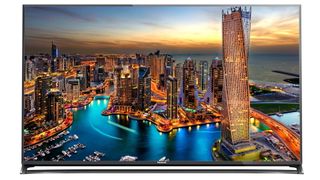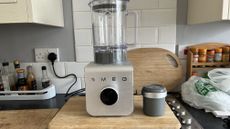With most rival TV brands peddling seriously cutting edge marketing messages for 2015 - High Dynamic Range (HDR) this, Android TV that, OLED TV the other - Panasonic's claim to deliver pictures that look exactly as the director intended feels, to be honest, a bit old fashioned. Worthy, certainly - especially for Panasonic's old plasma-loving fanbase - but nothing especially new.
There's also a sense of awkward timing about such a marketing push given the picture standards Panasonic's new TVs presumably strive to hit are in a state of flux right now, with HDR and accompanying new colour standards mere months away.
Actually, though, the 50CX802 has a rather handy trick up its sleeve.
For as well as apparently being able to perfectly adjust itself to today's existing standards, its new '4K Pro' picture engine will also handle HDR sources following a firmware update later in the year.
New processing and hardware tech
The 4K Pro technology comprises a mixture of hardware and software elements.
The hardware stuff is especially important from an HDR point of view, as it combines wide colour gamut (WCG) phosphors with a super-bright, ultra-transmissive panel - two things that seem on paper at least to be perfect partners for HDR's expanded contrast and colour range.
The WCG phosphors actually claim to deliver an even wider colour response than the Nano Crystal tech in Samsung's ultra-expensive JS9500 SUHD TVs.
On the software side, the 50CX802 uses a powerful new '4K Studio Master' processor in a bid to bring out image details other TVs cannot reach.
For instance, its colour mapping system has been borrowed from Panasonic's professional division and draws on around 8000 reference points (versus 100 or so on a typical LCD TV). It uses know-how ported from Panasonic's plasma division to eke out more subtle detail during dark scenes.
And, most intriguingly of all, 4K Pro also adapts non-UHD, non-HDR content to the TV's native UHD resolution and wide colour, high brightness panel - if you want it to.
We stress this last point since, in keeping with its appeal to the video enthusiast market, the 50CX802 offers enough flexibility with its picture tools to let you get pictures looking exactly as you want them to - including targeting with precision the established pre-HDR standards.
Smart Features
One further great new trick of the 50CX802 is its Mozilla Firefox operating system.
Instead of the over-bearing, dictatorial mess of the Android TV system spotted recently on Sony's 75X9405C, Firefox presents you with a slick, friendly, ultra-customisable interface that makes it easy for even the most technophobic user to quickly find their favourite content.

The Firefox system will soon be partnered via a firmware update with Freeview Play too, at which point the 50CX802 will offer a pretty comprehensive smart TV offering.
In action the 50CX802 does exactly what it says on the tin, producing pictures that might not be the most showy and dynamic around but which make up for this with a gorgeously deft touch that will should win it many fans - at least among serious movie lovers.
Picture Quality
The good news starts with the 50CX802's contrast performance - or more accurately, its ability to produce a really convincing black colour.
Dark scenes naturally benefit the most from the 50CX802's black level efforts, as it makes them look more natural, detailed and dynamic than they usually do on LCD TVs.
In fact, thanks, presumably, to the quality of the new 4K Studio Master processing system, dark scenes contain levels of shadow detail and colour tone subtlety that haven't been seen on a similarly priced LCD TV before.
In fact, so unLCD-like is the experience of watching the 50CX802 that it reminds you of the brand's plasma screens - which is, of course, exactly what the legions of fans of those now defunct screens want to hear. The amount of detail visible during dark scenes also helps them enjoy an impressive and immersive sense of depth versus the flat, hollow look seen on less able LCD TVs.

The colour accuracy and verve during dark scenes translates superbly well to bright scenes too, revealing saturations that are vivid, but not so much that the screen loses control of the balance and subtlety that Panasonic is so hell-bent on producing.
The precision of the 50CX802's colour and greyscale handling is a perfect fit for its native 4K resolution, too, helping it resolve every last one of all those extra pixels.
This helps the 50-inch 50CX802 roundly disprove the notion that you need a much larger screen to really appreciate a 4K UHD resolution. With native 4K content still disappointingly thin on the ground, it's also a relief to discover that the processing the 50CX802 uses to convert HD sources to its screen's 3840x2160 pixel count is superb.
The upscaled images look more densely textured and detailed without source noise being exaggerated or that eye-catching colour fidelity starting to slide.
Equally impressive is the way Panasonic's processors can remaster current picture standards to the wider colour gamut and higher brightness of its panel. This isn't done as aggressively as it is by Samsung's recently tested UE65JS9500, but Panasonic's more measured approach suits its other picture attributes perfectly.
There are things about the 50CX802 that mean it might not suit everyone. Its focus on subtlety and finesse comes at the expense of a little brightness and dynamism - so it may not be the best screen for a really bright room, and may not deliver the maximum impact from HDR sources when they appear.
There's a touch more lost resolution when showing moving objects and camera pans than you get with some rivals too, which sometimes slightly reduces the impact of the 4K screen, and occasionally the local dimming system the 50CX802 uses to deliver its mostly excellent black level response throws up subtle areas of clouding or light 'banding' around a bright object.
Sound quality
The 50CX802's audio is nothing special either.
It's powerful enough and clear enough not to be a distraction or succumb to nasty distortions, but at the same time it doesn't sound aggressive enough to convince during action scenes; its speakers don't have enough headroom to ebb and flow convincingly during dense mixes; and bass sounds both forced and dislocated.
This doesn't add up to audio that's by any means bad by the generally uninspiring standards of LCD TV sound, but it does prevent the set's sound from standing out from the crowd like its pictures do.

Verdict
While it's far from perfect, there's still overall a hell of a lot to like about the Panasonic 50CX802.
Its pictures are excellent in a unique way that's tailor made to appeal to the same enthusiast crowd that used to love Panasonic's plasma TVs. Its new smart system is up there with LG's webOS platform, and best of all it's excellent value considering what it offers.



